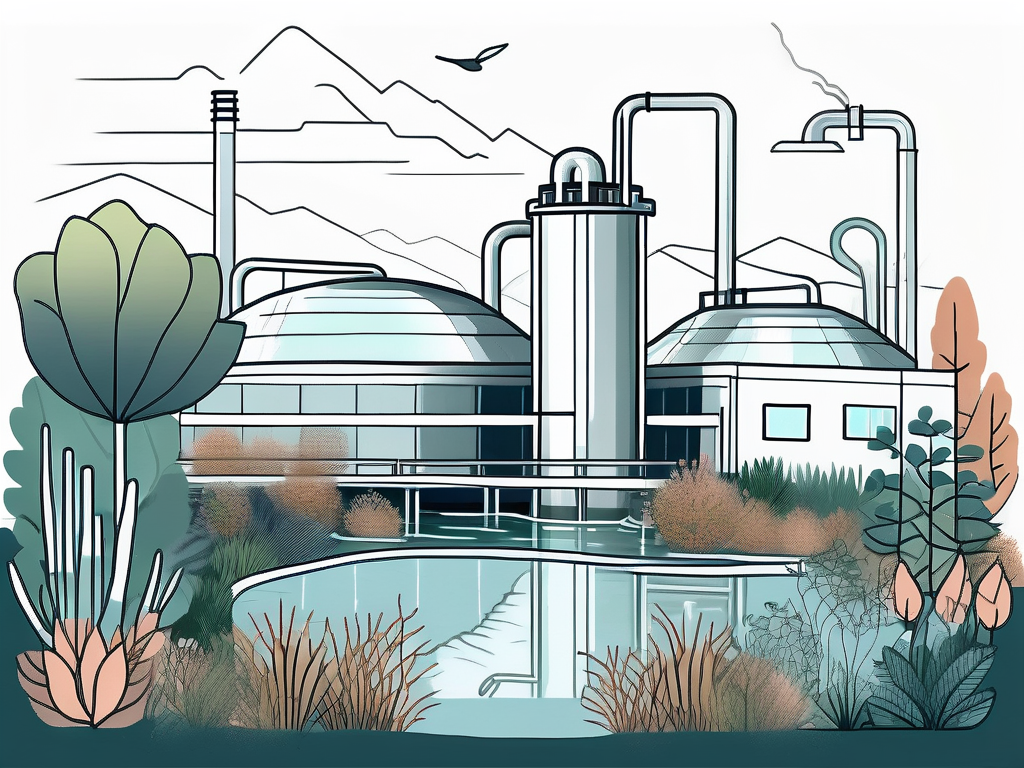
Volatile Organic Compounds: Wastewater Treatment Explained
Volatile Organic Compounds (VOCs) are a group of carbon-based chemicals that have high vapor pressure and low water solubility. Many VOCs are human-made chemicals that are used and produced in the process of manufacturing and use of paints, pharmaceuticals, and refrigerants. VOCs are common ground-water contaminants.
Wastewater treatment is a process used to convert wastewater into an effluent that can be returned to the water cycle with minimum impact on the environment, or directly reused. The latter is called water reclamation because treated wastewater can then be used for other purposes. The treatment process takes place in a wastewater treatment plant (WWTP), often referred to as a Water Resource Recovery Facility (WRRF) or a sewage treatment plant.
Understanding Volatile Organic Compounds
VOCs are organic chemicals that have a high vapor pressure at ordinary room temperature. Their high vapor pressure results from a low boiling point, which causes large numbers of molecules to evaporate or sublimate from the liquid or solid form of the compound and enter the surrounding air, a trait known as volatility.
Many VOCs are dangerous to human health or cause harm to the environment. Anthropogenic VOCs are regulated by law, especially indoors, where concentrations are the highest. Harmful VOCs typically are not acutely toxic, but have compounding long-term health effects. Because the concentrations are usually low and the symptoms slow to develop, research into VOCs and their effects is difficult.
Types of Volatile Organic Compounds
VOCs can be categorized into several types, depending on their chemical structure and properties. Some of the most common types include aldehydes, ketones, ethers, alcohols, and hydrocarbons. Each of these types has unique properties that make them more or less harmful to human health and the environment.
For example, aldehydes and ketones are often associated with strong odors and can cause irritation to the eyes, nose, and throat. Ethers and alcohols, on the other hand, are less likely to cause irritation but can still be harmful if inhaled in large amounts. Hydrocarbons, which include compounds like benzene and toluene, are known to be carcinogenic and can also cause damage to the nervous system.
Effects of Volatile Organic Compounds
VOCs can have a wide range of effects on human health and the environment. At low levels of exposure, VOCs can cause irritation to the eyes, nose, and throat, headaches, nausea, and can also damage the liver, kidney, and central nervous system. Long-term exposure can lead to chronic health conditions such as asthma, hypersensitivity, and can also increase the risk of cancer.
On the environment, VOCs contribute to the formation of ground-level ozone, a key component of smog. Ground-level ozone can harm vegetation, reducing crop yields and forest growth. It can also cause damage to buildings and other man-made materials.
Wastewater Treatment: An Overview
Wastewater treatment is a process that involves the removal of contaminants from wastewater to make it safe for discharge back into the environment or for reuse. The process involves several stages, each designed to remove or neutralize different types of contaminants.

The primary stage involves the removal of large solids and grit. This is followed by the secondary stage, which involves biological treatment to break down dissolved organic matter. The tertiary stage involves further treatment to remove remaining solids, disinfect the water, and sometimes remove nutrients.
Primary Treatment
Primary treatment is the first stage of the wastewater treatment process. The goal of this stage is to remove large solids and grit from the wastewater. This is typically achieved through the use of screens and grit chambers. Screens are used to catch large objects such as rags, sticks, and other debris, while grit chambers are used to settle out sand, gravel, and other heavy particles.
Once the large solids and grit have been removed, the wastewater is then sent to primary sedimentation tanks. Here, the wastewater is allowed to sit undisturbed for a period of time to allow the remaining solids to settle to the bottom. The settled solids, known as sludge, are then removed and treated separately.
Secondary Treatment
The secondary treatment stage is where the majority of the organic matter in the wastewater is removed. This is achieved through the use of biological processes. Microorganisms are used to consume the organic matter in the wastewater, converting it into water, carbon dioxide, and energy for their own growth and reproduction.
The most common method of secondary treatment is the activated sludge process. In this process, air is bubbled through the wastewater to encourage the growth of microorganisms. The microorganisms form clumps, or flocs, which can then be easily removed from the water.
Removal of Volatile Organic Compounds in Wastewater
The removal of VOCs from wastewater is a complex process that requires specialized treatment methods. These methods often involve physical, chemical, or biological processes, or a combination of these. The choice of method depends on the type and concentration of VOCs present, as well as other factors such as cost and regulatory requirements.
Physical methods for VOC removal include air stripping and activated carbon adsorption. Chemical methods include advanced oxidation processes, while biological methods involve the use of microorganisms to break down the VOCs. Each of these methods has its advantages and disadvantages, and the choice of method often depends on the specific circumstances of the wastewater treatment plant.
Air Stripping
Air stripping is a physical treatment method that involves the removal of VOCs from wastewater by transferring them to air. This is achieved by introducing air into the wastewater in a packed tower or aeration tank. The VOCs in the wastewater are then volatilized and carried away with the air.
While air stripping is effective for removing many types of VOCs, it is not suitable for all. Some VOCs, such as chlorinated solvents, are not easily volatilized and may require other treatment methods. Furthermore, air stripping can result in the release of VOCs into the atmosphere, which can contribute to air pollution.
Activated Carbon Adsorption
Activated carbon adsorption is another physical treatment method that can be used to remove VOCs from wastewater. This method involves passing the wastewater through a bed of activated carbon. The VOCs in the wastewater are then adsorbed onto the surface of the carbon particles.
Activated carbon adsorption is a versatile treatment method that can be used to remove a wide range of VOCs. However, the effectiveness of this method can be reduced over time as the activated carbon becomes saturated with VOCs. When this happens, the activated carbon must be replaced or regenerated, which can be costly.
Advanced Oxidation Processes
Advanced oxidation processes (AOPs) are chemical treatment methods that involve the generation of highly reactive oxygen species. These reactive species can then react with and break down the VOCs in the wastewater.
AOPs can be highly effective for removing VOCs, especially those that are not easily removed by other methods. However, AOPs can also be more costly than other treatment methods, and they can sometimes result in the formation of harmful byproducts.
Biological Treatment
Biological treatment involves the use of microorganisms to break down the VOCs in the wastewater. This is typically achieved through the use of a bioreactor, which provides the ideal conditions for the microorganisms to thrive.
Biological treatment can be an effective and environmentally friendly method for removing VOCs. However, not all VOCs can be easily broken down by microorganisms, and some may even be toxic to them. Therefore, the effectiveness of biological treatment can vary depending on the type and concentration of VOCs present.
Challenges and Future Directions
The treatment of wastewater containing VOCs presents several challenges. One of the main challenges is the wide variety of VOCs that can be present in wastewater, each with its own properties and treatment requirements. This makes it difficult to develop a one-size-fits-all treatment method.
Another challenge is the potential for the formation of harmful byproducts during the treatment process. For example, some treatment methods can result in the formation of halogenated organic compounds, which can be harmful to human health and the environment.
Emerging Treatment Technologies
Despite these challenges, there are several emerging treatment technologies that hold promise for the future. One of these is the use of nanotechnology. Nanomaterials, due to their small size and large surface area, have unique properties that make them effective for the removal of VOCs. For example, photocatalytic nanomaterials can be used to break down VOCs under the action of light.
Another promising technology is the use of biochar. Biochar is a type of charcoal that is produced from the pyrolysis of biomass. It has been found to be effective for the adsorption of VOCs, and it also has the added benefit of being a renewable resource.
Regulations and Standards
Regulations and standards for the treatment of wastewater containing VOCs vary by country and region. In general, these regulations are designed to protect human health and the environment by setting limits on the amount of VOCs that can be discharged in wastewater.
Compliance with these regulations can be challenging for wastewater treatment plants, especially those that are dealing with high concentrations of VOCs. However, with the development of new treatment technologies and methods, it is hoped that these challenges can be overcome.
Conclusion
In conclusion, the treatment of wastewater containing VOCs is a complex and challenging task. However, with the development of new technologies and methods, it is becoming increasingly possible to effectively remove these harmful compounds and protect human health and the environment.

As our understanding of VOCs and their effects on human health and the environment continues to grow, so too will our ability to effectively treat and manage wastewater containing these compounds. With continued research and innovation, the future of wastewater treatment looks promising.



